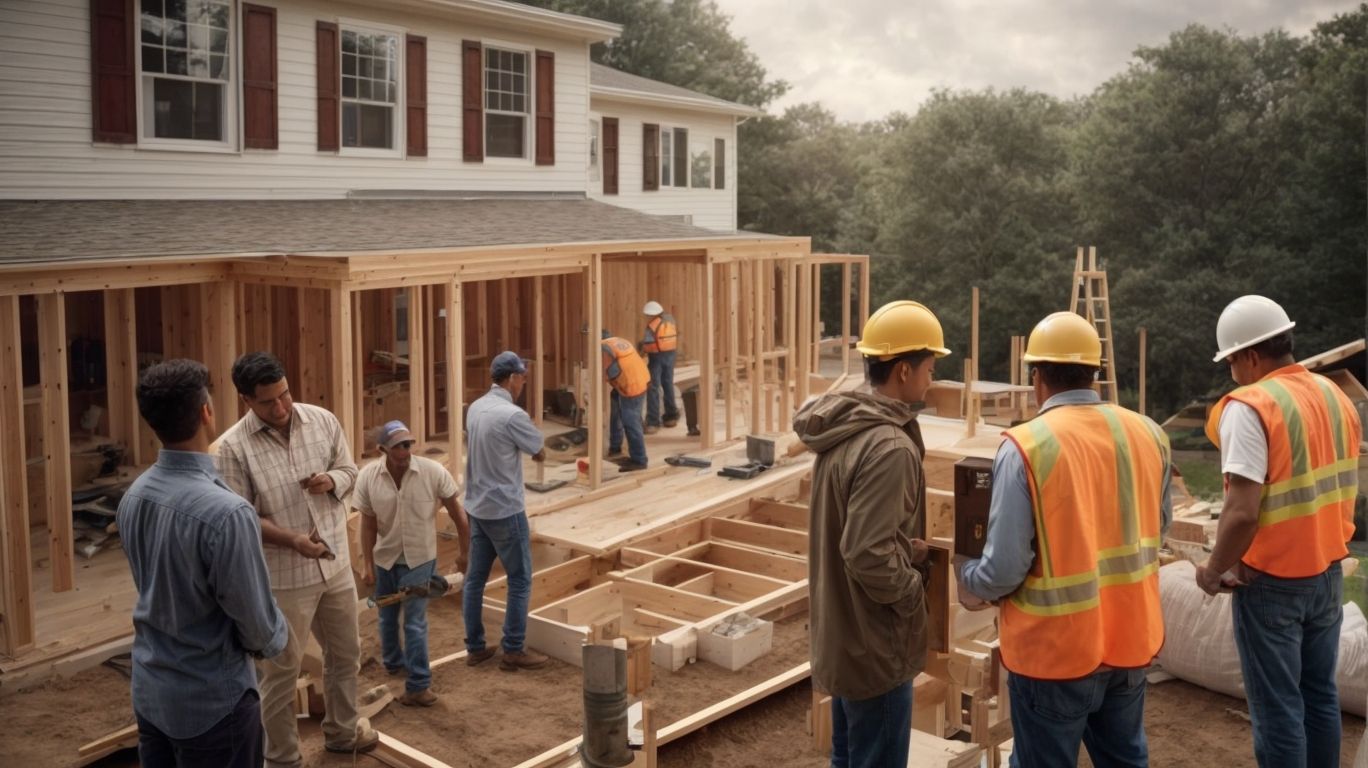
A Homeowner’s Guide to Hiring the Right Team for Your Second-Story Addition
Considering adding a second story to your home but unsure where to start? This comprehensive guide will walk you through the process of planning, choosing the right team, construction, and maintenance for your second-story addition. From increasing living space to preserving outdoor areas and avoiding moving costs, we cover everything you need to know to ensure a successful project. If you’re ready to elevate your home to new heights, keep reading for expert tips and advice.
What is a Second-Story Addition?
A Second-Story Addition involves expanding your home vertically by adding another level above the existing structure, typically to create additional living space or enhance the property’s value.
This type of renovation project offers homeowners the opportunity to increase their living area without encroaching on precious yard space. By building upwards, you can maximize your lot’s footprint, making it ideal for those with limited land availability.
A Second-Story Addition can significantly boost the market value of your home, providing a return on investment and increased desirability to potential buyers. It’s essential to consider structural integrity, zoning regulations, and budget constraints before embarking on such an extensive renovation.
Why Consider a Second-Story Addition?
Considering a Second-Story Addition can be a strategic decision for homeowners looking to increase living space, enhance property value, and potentially maximize their return on investment in the real estate market.
Expanding vertically with a second story not only allows for more living space without compromising outdoor areas but also adds substantial value to the property. This type of addition can significantly increase the overall square footage of a home, making it more attractive to potential buyers in the future. By maximizing the available space, homeowners can enjoy the benefits of a larger, more functional home while also securing a solid return on their investment when it comes time to sell.
Increase Living Space
One of the primary reasons to consider a Second-Story Addition is to increase the living space within your home, allowing for additional bedrooms, bathrooms, and overall room for various activities and functions.
Expanding upwards not only provides a solution for growing families but also offers a way to create dedicated spaces like a home office, a play area for children, or a cozy reading nook.
With the addition of bedrooms, guests can be comfortably accommodated, and teenagers can have their private sanctuary. Incorporating extra bathrooms helps in reducing morning rush hours and enhances convenience, especially during gatherings or when hosting overnight guests.
Preserve Outdoor Space
By opting for a Second-Story Addition, homeowners can preserve their outdoor space, such as yards or gardens, while still gaining the desired additional living area without compromising on the external environment.
The synergy created between the indoor comfort of the expanded living space and the outdoor aesthetics of the existing outdoor areas is a significant advantage of this approach. It allows individuals to enjoy the lush greenery and natural elements surrounding their property while enhancing the functionality and value of their home.
This harmonious blend of indoor and outdoor areas not only expands the living space vertically but also opens up opportunities for creative landscaping and outdoor leisure activities, providing a well-rounded living experience.
Avoid Moving Costs
Opting for a Second-Story Addition can help homeowners avoid significant moving costs associated with relocating to a larger property, allowing them to stay in their current neighborhood and community while upgrading their living space.
By choosing a Second-Story Addition, individuals can not only save money but also maintain their social connections within the neighborhood. This financial advantage not only influences individual households but also contributes to the overall stability and cohesion of the community. When residents choose to invest in expanding their current homes rather than moving, they are reinforcing the sense of community and long-term commitment to the area. This can lead to a more vibrant and interconnected neighborhood, creating a positive ripple effect on property values and community well-being.
How to Plan for a Second-Story Addition?
Planning for a Second-Story Addition involves meticulous considerations such as budgeting, design choices, and compliance with zoning laws and building regulations to ensure a successful and compliant construction process.
- First and foremost, setting a realistic budget is crucial to determine the scope of the project and avoid overspending. Researching costs for materials, labor, permits, and potential unexpected expenses will help in creating a comprehensive budget plan.
- Once the budget is established, making design selections that align with both aesthetic preferences and structural integrity is essential. Taking into account the existing architectural style of the home and blending it seamlessly with the new addition is key.
- Ensuring that the planned addition complies with local zoning laws and building codes is imperative to prevent any legal issues during or after the construction phase.
Determine Your Budget
- The first step in planning a Second-Story Addition is to determine your budget, considering cost estimates, potential impact on home equity, and financial readiness for the construction project.
- A realistic budget for a second-floor addition can vary significantly based on factors such as square footage, material choices, and labor costs. To ensure a comprehensive budget, it’s essential to obtain detailed quotes from contractors, factor in permit fees, and allocate funds for unexpected expenses that may arise during the construction process.
- Assessing the financial implications on your home equity is crucial as well, as funding a major renovation like this can affect your overall property value. Strategies to ensure adequate funding may include exploring financing options such as home equity loans or lines of credit, saving up over time, or refinancing your mortgage to access additional funds.
Consider Your Needs and Wants
When planning a Second-Story Addition, it’s essential to consider your specific needs and wants, focusing on design elements, floor plans, and aesthetics that align with your preferences and lifestyle.
Tailoring the design of your Second-Story Addition to suit your individual style can greatly impact the functionality and ambiance of your living space. By customizing the floor plan to accommodate your daily routines and activities, you can enhance both the comfort and practicality of the new space.
Making careful aesthetic choices, such as selecting color schemes, materials, and architectural details that resonate with your taste, can create an inviting and harmonious atmosphere in your home. The flexibility in design allows for personalization and ensures that the addition reflects your unique personality and vision.
Research Local Building Codes and Permits
Before proceeding with a Second-Story Addition, it’s crucial to research and understand local building codes, zoning laws, and permit requirements to ensure compliance and smooth progression of the construction project.
By investigating these regulations, homeowners can avoid potential setbacks, fines, or even having to demolish non-compliant structures. Building permits are essential to show that the construction plans meet safety standards and adhere to the fundamental guidelines laid out by the local government. Understanding zoning restrictions helps in determining what can be built on the property and where, ensuring that the project aligns with the neighborhood’s architectural aesthetics and overall development plans.
How to Choose the Right Team for Your Second-Story Addition?
Selecting the right team for your Second-Story Addition is a critical decision that involves diligent evaluation of contractors’ experience, skills, and communication abilities to ensure a successful and stress-free construction process.
One of the key criteria for choosing a competent team for your Second-Story Addition is to thoroughly assess the contractor’s qualifications. This includes verifying their licensing, insurance coverage, and certifications to guarantee they meet industry standards for quality workmanship and adherence to safety regulations.
Experience evaluation is also crucial; consider the number of years the contractor has been in business, their portfolio of past projects, and any specialized skills or expertise they bring to the table.
Effective communication is vital in any construction project, so prioritize contractors who are transparent, responsive, and able to clearly articulate their plans and timelines throughout the process.
Ask for Recommendations
Seeking recommendations from trusted sources and reviewing past client feedback can provide valuable insights into selecting a reputable team for your Second-Story Addition, ensuring quality workmanship and customer satisfaction.
When considering potential contractors for your project, take the time to ask for references and read through reviews online. By reaching out to previous clients, you can gain firsthand knowledge of the team’s work ethic, communication skills, and ability to meet deadlines. Analyzing feedback received from multiple sources gives you a well-rounded view of the contractor’s performance and helps you make an informed decision. Positive reviews often highlight the strengths of the team, while any red flags in feedback can alert you to potential issues that may arise during your project.
Check Credentials and Experience
Evaluating the credentials, skills, and experience of potential contractors for your Second-Story Addition is essential to ensure competence, professionalism, and liability coverage throughout the construction process.
Expertise plays a critical role in the success of your project, as skilled contractors bring knowledge and precision to the intricate process of adding a second story to your home.
Liability considerations cannot be overlooked, as hiring a contractor with proper insurance coverage safeguards you from potential financial risks in case of accidents or damages during the construction.
Professional qualifications, such as licenses, certifications, and industry affiliations, indicate a contractor’s commitment to excellence and adherence to industry standards, providing you with peace of mind and assurance of a job well done.
Get Multiple Quotes
Obtaining multiple quotes from different contractors for your Second-Story Addition allows for comparison of estimates, contract terms, and project timelines, enabling informed decision-making and cost-effective selections.
By soliciting various quotes, homeowners can gain insights into the range of cost estimates and understand what each contractor includes in their proposal. This comparative analysis not only aids in selecting the most competitive offer but also helps in negotiating favorable contract terms.
Assessing the projected timelines outlined by different contractors can provide clarity on the expected duration of the project, ensuring alignment with your schedule and avoiding unnecessary delays.
What to Expect During the Construction Process?
The construction process of a Second-Story Addition involves various stages, including demolition, framing, installations, and finishing work, requiring meticulous project management to ensure structural integrity, compliance, and quality outcomes.
Throughout the construction phases, project managers play a crucial role in coordinating different teams, communicating progress updates, and ensuring that the project stays on schedule and within budget.
Structural integrity considerations are paramount, involving meticulous planning to support the added weight and ensure the stability of the existing structure. Quality control measures are implemented to guarantee that materials used meet standards, craftsmanship is of high quality, and all installations are done correctly to achieve a seamless second-story addition.
Demolition and Preparation
The initial phase of a Second-Story Addition involves demolition and site preparation, including tasks such as roofing adjustments, mobilizing the construction crew, and ensuring safety protocols for a smooth project commencement.
Roofing adjustments play a critical role in the construction process, as the existing roof structures may need to be modified or removed to accommodate the new addition. Coordination among the crew members is essential during this stage to ensure that tasks are carried out efficiently and according to the project timeline. Emphasis is placed on adhering to construction safety standards, such as wearing personal protective equipment, setting up safety barriers, and conducting regular safety meetings to mitigate potential risks on the work site.
Framing and Structural Work
Framing and structural work during a Second-Story Addition are paramount for ensuring the stability, compliance with building codes, and adherence to regulations to guarantee the structural integrity and safety of the expanded property.
Proper framing establishes the skeleton of the new addition, ensuring that the weight is properly distributed and supported. This is vital to prevent structural issues such as sagging or uneven floors.
By following construction regulations and building codes, homeowners can rest assured that their project meets industry standards for safety and durability. Aligning with regulatory requirements not only enhances the structural stability of the property but also avoids potential legal implications in the future.
Investing in quality framing and structural work ultimately pays off in a solid, secure, and long-lasting second-story addition.
Electrical, Plumbing, and HVAC Installation
The installation of electrical, plumbing, and HVAC systems in a Second-Story Addition requires meticulous planning, skilled professionals, and compliance with safety standards to ensure functional efficiency, safety, and comfort within the new living space.
One of the critical aspects of installing these systems is ensuring that the electrical wiring is correctly laid out to support the increased energy demands of the expanded space. Skilled electricians must carefully plan the placement of outlets, switches, and lighting fixtures to optimize functionality and aesthetics.
The HVAC system installation should be handled by experienced technicians to ensure proper ventilation, heating, and cooling throughout the addition. Compliance with safety regulations is paramount to safeguard against potential hazards and ensure the longevity of the systems.
Finishing Work and Final Inspections
The completion phase of a Second-Story Addition involves finishing work to enhance aesthetics, increase property value, and undergo final inspections for regulatory compliance and quality assurance before occupancy or use.
During this stage, attention is given to detailing tasks such as painting, flooring installation, trim work, and fixture placement to ensure a cohesive and visually appealing finish.
Professionals conduct thorough inspections to check for structural integrity, adherence to building codes, and the functionality of electrical and plumbing systems. These inspections are critical in confirming the safety and durability of the newly added space.
Assessments for energy efficiency and insulation adequacy are carried out to optimize the overall performance of the property. These meticulous processes contribute to both the aesthetic appeal and the long-term value appreciation of the Second-Story Addition.
How to Maintain Your Second-Story Addition?
Maintaining your Second-Story Addition involves regular cleaning, timely issue resolution, and insurance upkeep to ensure long-term quality, safety, and compliance with energy-efficient practices for sustainable living.
To keep your second-story addition in top condition, it is essential to establish a cleaning routine that includes dusting high surfaces, vacuuming carpets, and washing windows regularly.
Monitoring for any potential issues like leaks, cracks, or mold growth is crucial for maintaining a safe and healthy living environment.
Staying up to date on insurance coverage specific to your addition can provide financial protection in case of unexpected damages or accidents.
By incorporating these maintenance practices into your routine, you can ensure that your second-story addition remains a comfortable and energy-efficient space for years to come.
Regular Cleaning and Maintenance
Regular cleaning and maintenance routines are essential for preserving the quality, safety, and aesthetics of your Second-Story Addition, ensuring a comfortable and functional living environment for the occupants.
By implementing consistent cleaning practices, you can prevent dust buildup, mold growth, and potential structural damage, maintaining a pristine and healthy indoor atmosphere.
Safety standards should not be overlooked, with routine inspections of railings, stairs, and walkways to ensure stability and reduce the risk of accidents.
Regular maintenance not only enhances the longevity of your property but also promotes a sense of well-being and cleanliness that contributes to a harmonious home environment.
Address Any Issues Promptly
Promptly addressing any issues or repairs in your Second-Story Addition is crucial to prevent escalation, maintain property value, and foster effective communication between homeowners and maintenance professionals for sustainable living conditions.
By promptly addressing issues such as leaks, structural concerns, or electrical problems, you can avoid costly repairs and ensure the longevity of your second-story addition.
Good communication between homeowners and maintenance professionals is key to swiftly resolving any issues that arise, preventing small problems from turning into major headaches.
Proactive maintenance strategies, like regular inspections and timely repairs, play a significant role in preserving the value of your property and enhancing the overall living experience in your home.
Keep Up with Homeowners Insurance
Ensuring continuous coverage through homeowners insurance for your Second-Story Addition is essential to mitigate liability risks, protect property value, and safeguard against unexpected damages or incidents within the expanded living space.
By having adequate insurance coverage in place, you not only shield yourself from potential financial burdens resulting from accidents or injuries on your property but also maintain the value of your home in case of unforeseen events.
Incorporating risk management strategies within your insurance policy can provide additional layers of protection, ensuring that you are well-prepared to handle any unexpected circumstances that may arise.
Remember, investing in homeowners insurance for your Second-Story Addition is not just about compliance; it is a proactive measure to secure your assets and peace of mind.




No Comments